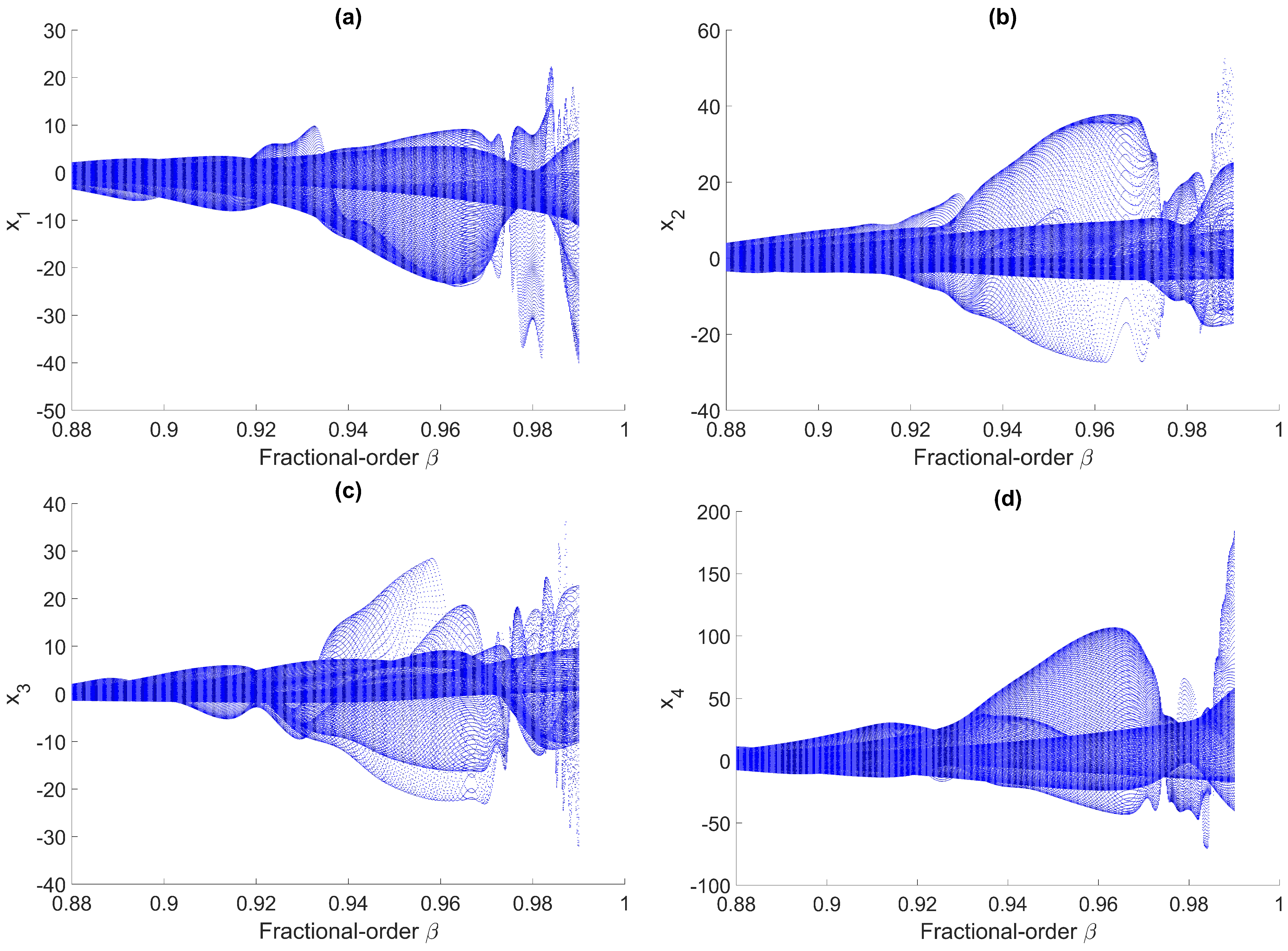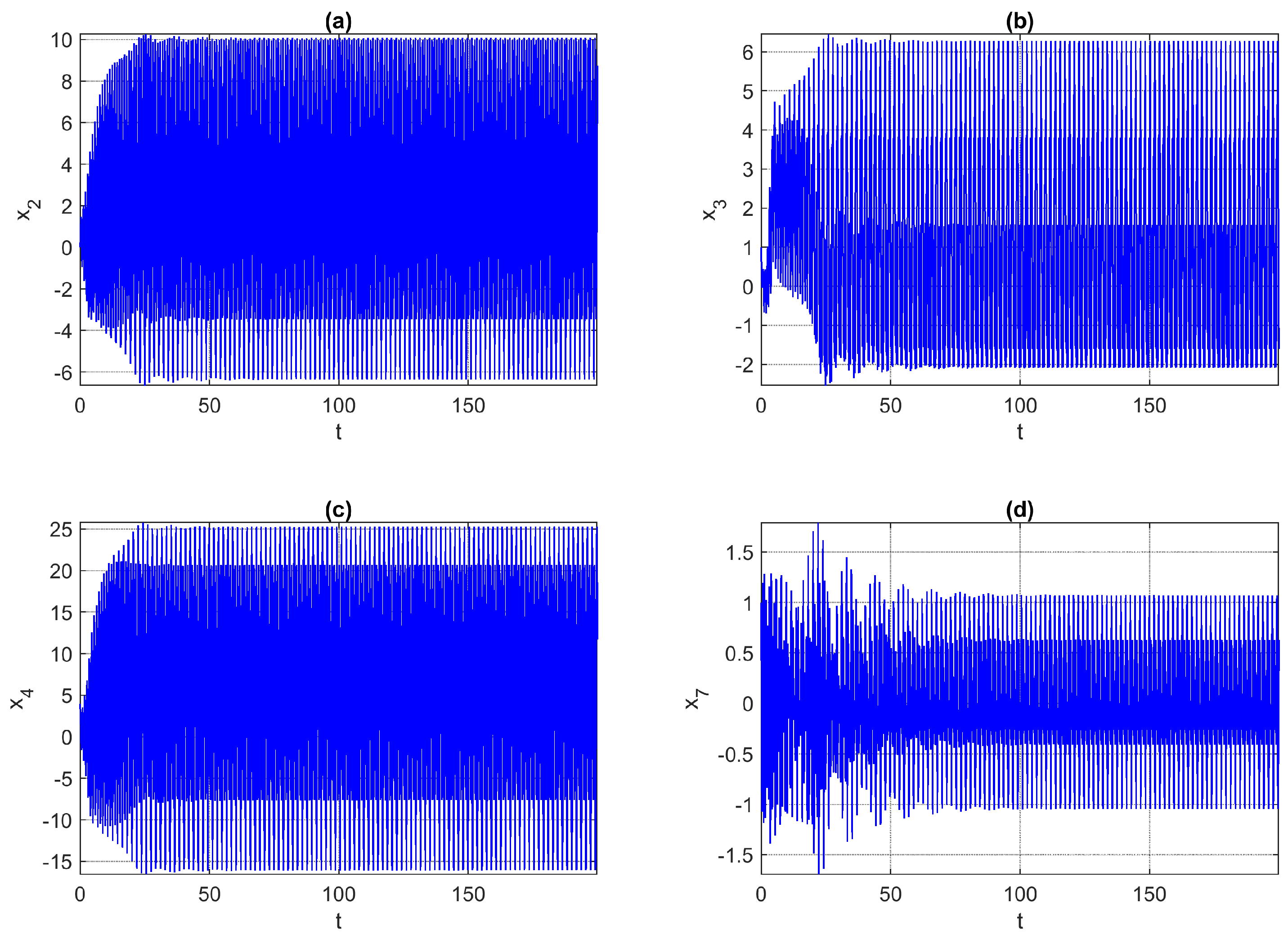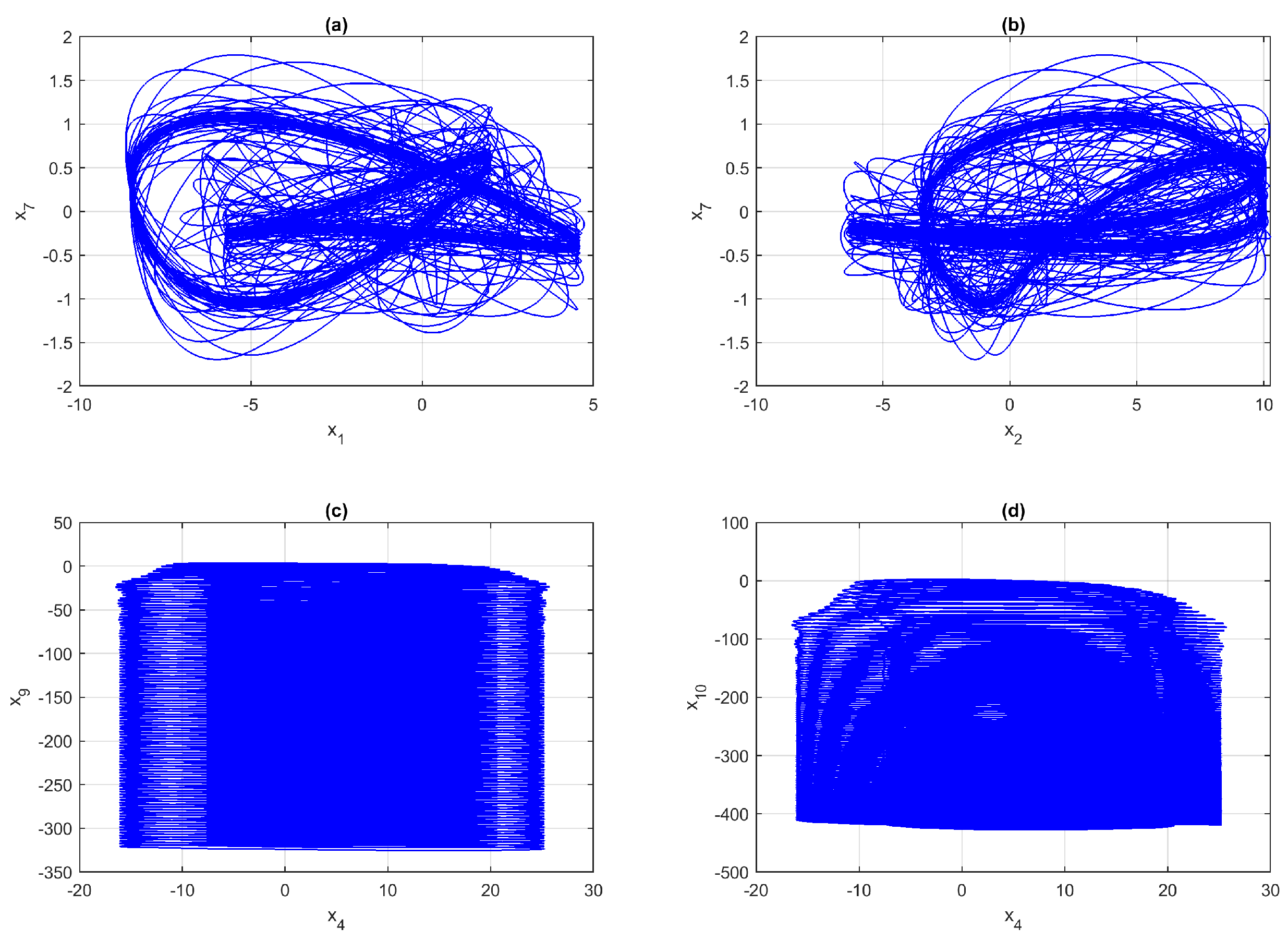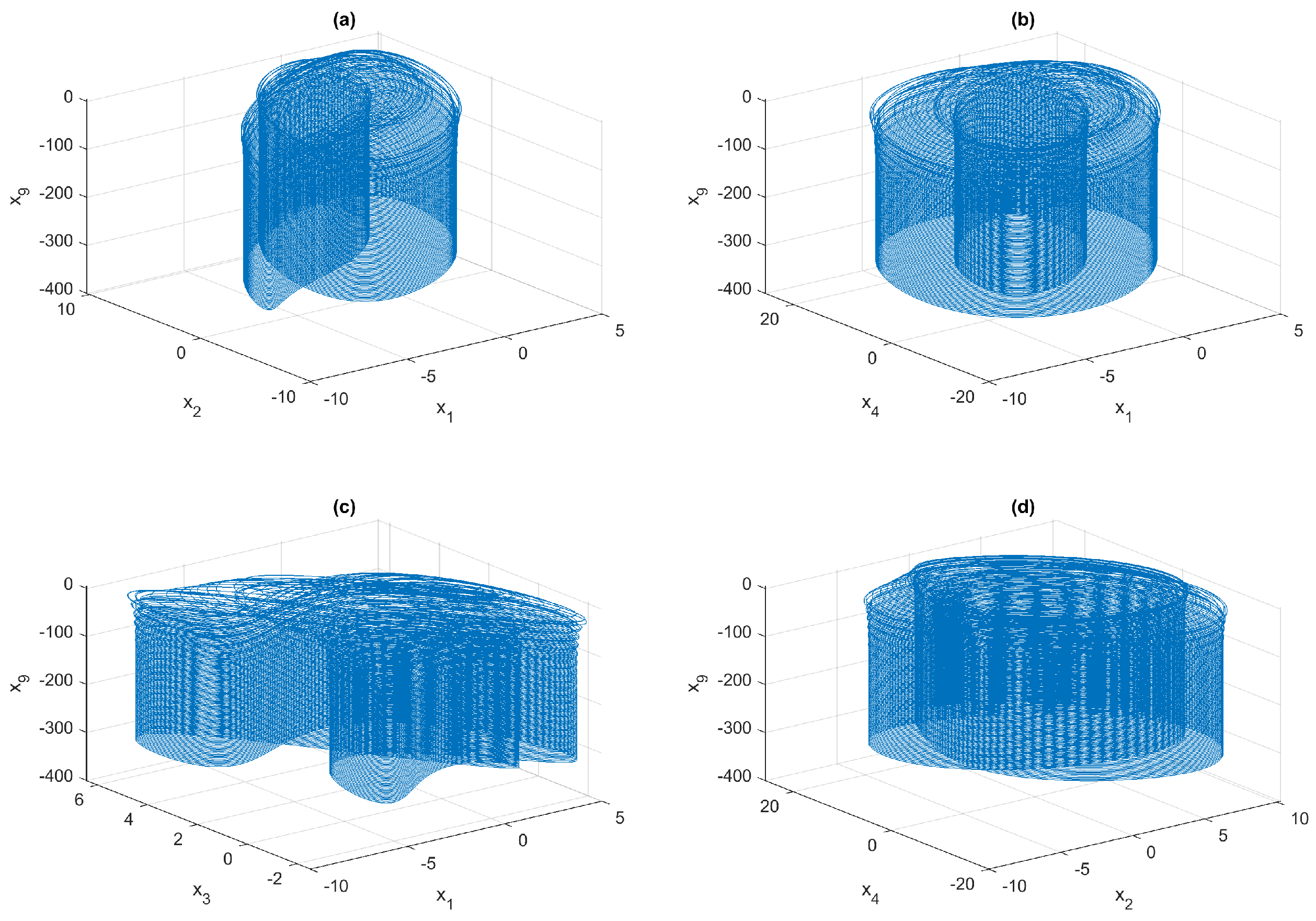Dynamic Analysis of a 10-Dimensional Fractional-Order Hyperchaotic System Using Advanced Hyperchaotic Metrics
Abstract
1. Introduction
- The integration of fractional-order derivatives into the Chen system provides a generalized framework that enables the modeling of a wider spectrum of dynamic behaviors. This extension enhances its relevance in various domains where nonlocal memory effects are critical for accurate representation.
- FO operators offer a more versatile and precise approach to representing memory and hereditary characteristics inherent in numerous real-world phenomena. Unlike traditional integer-order models that emphasize local interactions, FO models incorporate the complete historical behavior of state variables, allowing for more accurate simulation of systems with long-term temporal dependencies.
- The inclusion of fractional-order derivatives introduces greater complexity to the system’s dynamics, resulting in a broader array of bifurcation patterns and chaotic attractors. This increased complexity makes the FO Chen system more capable of describing intricate chaotic phenomena encountered in fields such as physics, biology, and engineering.
- The FO Chen system demonstrates chaotic dynamics at lower parameter thresholds compared to its classical counterpart. This property is particularly beneficial for applications relying on chaos, such as secure communication in cryptography and efficient random number generation.
2. Mathematical Model and Computational Technique
2.1. Basic Idea
2.2. Development of the Proposed Method
| Algorithm 1 Numerical simulations for the presented FOS |
|
3. Numerical Simulation and Investigation of the Designed System
3.1. Analysis of Lyapunov Exponents (LEs) for Hyperchaotic Behavior
- This configuration provides an asymmetry that enhances the exploration of divergent trajectories, a critical feature for studying chaotic and hyperchaotic systems.
- The selected initial conditions avoid trivial solutions (e.g., all zeros) and ensure that the numerical integration methods (e.g., G-L) converge reliably within the defined time step.
- The values are chosen to initialize the system far from equilibrium points, facilitating a thorough exploration of the attractor structure.
Lyapunov Exponents and Non-Locality
| Algorithm 2 Addressing non-locality in fractional-order systems |
|
3.2. Bifurcation Analysis of the Proposed System
- As varies over , the diagrams for (a) , (b) , and (c) showcase complex and chaotic behaviors, with evident bifurcation patterns indicating high sensitivity to changes in .
- For within the range , the diagrams of (d) , (e) , and (f) illustrate dynamic transitions and bifurcation phenomena, underscoring the parameter’s influence on system complexity and sensitivity.
- Varying from 0 to 3 in subfigures (g) , (h) , and (i) further highlights hyperchaotic characteristics, with the diagrams demonstrating extensive transitions and sensitivity across the specified range.

3.3. Phase Diagrams and Dynamical Trajectories
4. Complexity and Chaotic Properties of the Proposed FOS
4.1. Analysis of 0-1 Test for Chaos
4.2. LEs and Kaplan–Yorke Dimension
| Algorithm 3 Compute Kaplan–Yorke dimension () using MATLAB |
|
4.3. Kolmogorov–Sinai (KS) Entropy
4.4. Analysis of Perron Effect
5. Quantitative Comparison and Complexity Analysis
5.1. Error Margins
5.2. Computational Complexity
5.3. Implementation Challenges and Computational Overhead
6. Results and Discussions
7. Summary of Results
8. Future Recommendations and Applications
Author Contributions
Funding
Data Availability Statement
Conflicts of Interest
References
- Lorenz, E.N. Deterministic nonperiodic flow. J. Atmos. Sci. 1963, 20, 130–141. [Google Scholar] [CrossRef]
- Strogatz, S.H. Nonlinear Dynamics and Chaos: With Applications to Physics, Biology, Chemistry, and Engineering; Westview Press: Boulder, CO, USA, 1994. [Google Scholar]
- Shen, B.W.; Pielke, R.A., Sr.; Zeng, X.; Baik, J.J.; Faghih-Naini, S.; Cui, J.; Atlas, R. Is weather chaotic? Coexistence of chaos and order within a generalized Lorenz model. Bull. Am. Meteorol. Soc. 2021, 102, E148–E158. [Google Scholar] [CrossRef]
- Mahmoud, E.E.; Trikha, P.; Jahanzaib, L.S.; Almaghrabi, O.A. Dynamical analysis and chaos control of the fractional chaotic ecological model. Chaos Solitons Fractals 2020, 141, 110348. [Google Scholar] [CrossRef]
- Anderson, D.M.; Gillooly, J.F. Allometric scaling of Lyapunov exponents in chaotic populations. Popul. Ecol. 2020, 62, 364–369. [Google Scholar] [CrossRef]
- Leonov, G.A.; Kuznetsov, N.V.; Vagaitsev, V.I. Localization of hidden Chua’s attractors. Phys. Lett. A 2011, 375, 2230–2233. [Google Scholar] [CrossRef]
- Gonchenko, A.S.; Gonchenko, S.V. Variety of strange pseudohyperbolic attractors in three-dimensional generalized Henon maps. Phys. D Nonlinear Phenom. 2016, 337, 43–57. [Google Scholar] [CrossRef]
- Chen, G.; Ueta, T. Yet another chaotic attractor. Int. J. Bifurc. Chaos 1999, 9, 1465–1466. [Google Scholar] [CrossRef]
- Jafari, S.; Sprott, J. Simple chaotic flows with a line equilibrium. Chaos Solitons Fractals 2013, 57, 79–84. [Google Scholar] [CrossRef]
- Molaie, M.; Jafari, S.; Sprott, J.C.; Golpayegani, S.M.R.H. Simple chaotic flows with one stable equilibrium. Int. J. Bifurc. Chaos 2013, 23, 1350188. [Google Scholar] [CrossRef]
- Dudkowski, D.; Jafari, S.; Kapitaniak, T.; Kuznetsov, N.V.; Leonov, G.A.; Prasad, A. Hidden attractors in dynamical systems. Phys. Rep. 2016, 637, 1–50. [Google Scholar] [CrossRef]
- Petras, I. Fractional-Order Nonlinear Systems: Modeling, Analysis and Simulation; Springer: Berlin/Heidelberg, Germany, 2011. [Google Scholar]
- Hilfer, R. Fractional diffusion based on Riemann-Liouville fractional derivatives. J. Phys. Chem. B 2000, 104, 3914–3917. [Google Scholar] [CrossRef]
- Atangana, A.; Baleanu, D.; Alsaedi, A. New properties of conformable derivative. Open Math. 2015, 13, 000010151520150081. [Google Scholar] [CrossRef]
- Syam, M.I.; Al-Refai, M. Fractional differential equations with Atangana–Baleanu fractional derivative: Analysis and applications. Chaos Solitons Fractals X 2019, 2, 100013. [Google Scholar] [CrossRef]
- Podlubny, I. Fractional Differential Equations. In Mathematics in Science and Engineering Series; Academic Press: Cambridge, MA, USA, 1998. [Google Scholar]
- Grunwald, A.K. Ueber “begrenzte” Derivationen und deren Anwendung. Z. Angew. Math. Phys. 1867, 12, 441–480. [Google Scholar]
- Letnikov, A.V. Theory of differentiation of fractional order. Mat. Sb. 1868, 3, 1868. [Google Scholar]
- Qin, H.; Li, L.; Li, Y.; Chen, X. Time-Stepping Error Estimates of Linearized Grünwald-Letnikov Difference Schemes for Strongly Nonlinear Time-Fractional Parabolic Problems. Fractal Fract. 2024, 8, 390. [Google Scholar] [CrossRef]
- Abdel Aal, M. New Perturbation–Iteration Algorithm for Nonlinear Heat Transfer of Fractional Order. Fractal Fract. 2024, 8, 313. [Google Scholar] [CrossRef]
- Tian, H.; Zhao, M.; Liu, J.; Wang, Q.; Yu, X.; Wang, Z. Dynamic Analysis and Sliding Mode Synchronization Control of Chaotic Systems with Conditional Symmetric Fractional-Order Memristors. Fractal Fract. 2024, 8, 307. [Google Scholar] [CrossRef]
- Dehingia, K.; Boulaaras, S. The Stability of a Tumor–Macrophages Model with Caputo Fractional Operator. Fractal Fract. 2024, 8, 394. [Google Scholar] [CrossRef]
- Camplani, M. Data Analysis Techniques for Nonlinear Dynamical Systems. Ph.D. Thesis, University of Cagliari, Cagliari, Italy, 2010. [Google Scholar]
- Ben Makhlouf, A.; El-Hady, E.S. Novel stability results for Caputo fractional differential equations. Math. Probl. Eng. 2021, 2021, 9817668. [Google Scholar] [CrossRef]
- Sene, N. Analysis of a fractional-order chaotic system in the context of the Caputo fractional derivative via bifurcation and Lyapunov exponents. J. King Saud-Univ.-Sci. 2021, 33, 101275. [Google Scholar] [CrossRef]
- Gao, Y.; Liang, C.; Wu, Q.; Yuan, H. A new fractional-order hyperchaotic system and its modified projective synchronization. Chaos Solitons Fractals 2015, 76, 190–204. [Google Scholar] [CrossRef]
- Wang, Z.; Liu, J.; Zhang, F.; Leng, S. Hidden chaotic attractors and synchronization for a new fractional-order chaotic system. J. Comput. Nonlinear Dyn. 2019, 14, 081010. [Google Scholar] [CrossRef]
- Li, K.; Cao, J.; He, J.M. Hidden hyperchaotic attractors in a new 4D fractional-order system and its synchronization. Chaos Interdiscip. J. Nonlinear Sci. 2020, 30, 2020. [Google Scholar] [CrossRef] [PubMed]
- Sarfraz, M.; Zhou, J.; Ali, F. An 8D Hyperchaotic System of Fractional-Order Systems Using the Memory Effect of Grünwald-Letnikov Derivatives. Fractal Fract. 2024, 8, 530. [Google Scholar] [CrossRef]
- Diethelm, K. Multi-term fractional differential equations, multi-order fractional differential systems, and their numerical solutions. J. Eur. Syst. Autom. 2008, 42, 665–676. [Google Scholar] [CrossRef]
- Jiao, Z.; Chen, Y.Q. Stability of fractional-order linear time-invariant systems with multiple noncommensurate orders. Comput. Math. Appl. 2012, 64, 3053–3058. [Google Scholar] [CrossRef]
- Brandibur, O.; Kaslik, E. Stability analysis of multi-term fractional-differential equations with three fractional derivatives. J. Math. Anal. Appl. 2021, 495, 124751. [Google Scholar] [CrossRef]
- Atanackovic, T.; Dolicanin, D.; Pilipovic, S.; Stankovic, B. Cauchy problems for some classes of linear fractional differential equations. Fract. Calc. Appl. Anal. 2014, 17, 1039–1059. [Google Scholar] [CrossRef]
- Yu, F.; Zhang, W.; Xiao, X.; Yao, W.; Cai, S.; Zhang, J.; Wang, C.; Li, Y. Dynamic Analysis and Field-Programmable Gate Array Implementation of a 5D Fractional-Order Memristive Hyperchaotic System with Multiple Coexisting Attractors. Fractal Fract. 2024, 8, 271. [Google Scholar] [CrossRef]
- Mahmoud, E.E.; Higazy, M.; Al-Harthi, T.M. A New Nine-Dimensional Chaotic Lorenz System with Quaternion Variables: Complicated Dynamics, Electronic Circuit Design, Anti-Anticipating Synchronization, and Chaotic Masking Communication Application. Mathematics 2019, 7, 877. [Google Scholar] [CrossRef]
- Zhu, J.L.; Dong, J.; Gao, H.Q. Nine-Dimensional Eight-Order Chaotic System and its Circuit Implementation. Appl. Mech. Mater. 2014, 716–717, 1346–1351. [Google Scholar] [CrossRef]
- Zhu, J.; Kang, S.; Gao, H.; Wang, Y. 10-Dimensional Nine-Order Chaotic System and its Circuit Implementation. In Proceedings of the IEEE 12th International Conference on Electronic Measurement and Instruments, ICEMI, Qingdao, China, 16–18 July 2015; pp. 964–968. [Google Scholar]
- Lu, T.; Li, C.; Wang, X.; Tao, C.; Liu, Z. A memristive chaotic system with offset-boostable conditional symmetry. Eur. Phys. J. Spec. Top. 2020, 229, 1059–1069. [Google Scholar] [CrossRef]
- Gottwald, G.A.; Melbourne, I. A new test for chaos in deterministic systems. Proc. R. Soc. Lond. Ser. A Math. Phys. Eng. Sci. 2004, 460, 603–611. [Google Scholar] [CrossRef]
- Falconer, I.; Gottwald, G.A.; Melbourne, I.; Wormnes, K. Application of the 0-1 test for chaos to experimental data. SIAM J. Appl. Dyn. Syst. 2007, 6, 395–402. [Google Scholar] [CrossRef]
- Gottwald, G.A.; Melbourne, I. On the implementation of the 0-1 test for chaos. SIAM J. Appl. Dyn. Syst. 2009, 8, 129–145. [Google Scholar] [CrossRef]
- Chen, Z.M. A note on Kaplan-Yorke-type estimates on the fractal dimension of chaotic attractors. Chaos Solitons Fractals 1993, 3, 575–582. [Google Scholar] [CrossRef]
- Hu, Z.; Chan, C.K. A 7-D hyperchaotic system-based encryption scheme for secure fast-OFDM-PON. J. Light. Technol. 2018, 36, 3373–3381. [Google Scholar] [CrossRef]
- Yang, Q.; Zhu, D.; Yang, L. A new 7D hyperchaotic system with five positive Lyapunov exponents coined. Int. J. Bifurc. Chaos 2018, 28, 1850057. [Google Scholar] [CrossRef]
- Yu, W.; Wang, J.; Wang, J.; Zhu, H.; Li, M.; Li, Y.; Jiang, D. Design of a New Seven-Dimensional Hyperchaotic Circuit and Its Application in Secure Communication. IEEE Access 2019, 7, 125586–125608. [Google Scholar] [CrossRef]
- Lagmiri, S.N.; Amghar, M.; Sbiti, N. Seven Dimensional New Hyperchaotic Systems: Dynamics and Synchronization by a High Gain Observer Design. Int. J. Control Autom. 2017, 10, 251–266. [Google Scholar] [CrossRef]
- Varan, M.; Akgul, A. Control and synchronisation of a novel seven-dimensional hyperchaotic system with active control. Pramana 2018, 90, 1–8. [Google Scholar] [CrossRef]
- Biban, G.; Chugh, R.; Panwar, A. Image encryption based on 8D hyperchaotic system using Fibonacci Q-Matrix. Chaos Solitons Fractals 2023, 170, 113396. [Google Scholar] [CrossRef]
- Sinai, Y. Kolmogorov-sinai entropy. Scholarpedia 2009, 4, 2034. [Google Scholar] [CrossRef]
- Pesin, Y.B. Characteristic Lyapunov exponents and smooth ergodic theory. Russ. Math. Surv. 1977, 32, 55. [Google Scholar] [CrossRef]
- Benkouider, K.; Bouden, T.; Sambas, A.; Lekouaghet, B.; Mohamed, M.A.; Ibrahim Mohammed, S.; Ahmad, M.Z. A new 10-D hyperchaotic system with coexisting attractors and high fractal dimension: Its dynamical analysis, synchronization and circuit design. PLoS ONE 2022, 17, e0266053. [Google Scholar] [CrossRef]
- Rössler, O.E. An equation for continuous chaos. Phys. Lett. A 1979, 57, 397–398. [Google Scholar] [CrossRef]
- Gao, W.; Veeresha, P.; Cattani, C.; Baishya, C.; Baskonus, H.M. Modified predictor–corrector method for the numerical solution of a fractional-order SIR model with 2019-nCoV. Fractal Fract. 2022, 6, 92. [Google Scholar] [CrossRef]
- Diethelm, K.; Ford, N.J.; Freed, A.D. A Predictor-Corrector Approach for the Numerical Solution of Fractional Differential Equations. Nonlinear Dyn. 2001, 29, 3–22. [Google Scholar] [CrossRef]










| Different Parameters | Limit Set | ||||||||||
|---|---|---|---|---|---|---|---|---|---|---|---|
| 1.16 | 0.84 | 0.29 | 0.20 | 0.07 | 0.05 | −1.07 | −1.20 | −2.04 | −4.13 | Hyperchaotic | |
| 2.53 | 1.33 | 0.59 | 0.58 | 0.57 | 0.46 | 0.26 | −0.07 | −0.63 | −8.11 | Hyperchaotic | |
| 1.44 | 0.82 | 0.45 | 0.30 | 0.30 | 0.16 | 0.07 | 0.03 | −0.58 | −8.09 | Hyperchaotic |
| Range of | Number of Values Assessed | Minimum +ve LEs | Sum of LEs | Nature |
|---|---|---|---|---|
| to | 423 | 4 | −ve | Hyperchaotic |
| to | 176 | 6 | −ve | Hyperchaotic |
| to | 400 | 5 | −ve | Hyperchaotic |
| 1.056830 | 1.160566 | 1.123059 | 0.819398 |
| ODE Systems | Fractal Dimensions |
|---|---|
| Proposed 10D system for | 8.164 |
| Proposed 10D system for | 9.693 |
| Proposed 10D system for | 9.369 |
| 7D system proposed by Hu and Chan [43] | 6.732 |
| 7D system introduced by Yang [44] | 6.149 |
| 7D system developed by Yu et al. [45] | 5.278 |
| 7D system described by Lagmiri et al. [46] | 2.091 |
| 7D system presented by Varan and Akgul [47] | 2.175 |
| 8D system constructed by Biban et al. [48] | 7.13 |
| 9D system outlined by Mahmoud et al. [35] | 5.128 |
| 9D system reported by Zhu et al. [36] | 2.171 |
| 10D system established by Jianliang et al. [37] | 2.429 |
Disclaimer/Publisher’s Note: The statements, opinions and data contained in all publications are solely those of the individual author(s) and contributor(s) and not of MDPI and/or the editor(s). MDPI and/or the editor(s) disclaim responsibility for any injury to people or property resulting from any ideas, methods, instructions or products referred to in the content. |
© 2025 by the authors. Licensee MDPI, Basel, Switzerland. This article is an open access article distributed under the terms and conditions of the Creative Commons Attribution (CC BY) license (https://creativecommons.org/licenses/by/4.0/).
Share and Cite
Sarfraz, M.; Zhou, J.; Islam, M.; Rasheed, A.; Liu, Q. Dynamic Analysis of a 10-Dimensional Fractional-Order Hyperchaotic System Using Advanced Hyperchaotic Metrics. Fractal Fract. 2025, 9, 76. https://doi.org/10.3390/fractalfract9020076
Sarfraz M, Zhou J, Islam M, Rasheed A, Liu Q. Dynamic Analysis of a 10-Dimensional Fractional-Order Hyperchaotic System Using Advanced Hyperchaotic Metrics. Fractal and Fractional. 2025; 9(2):76. https://doi.org/10.3390/fractalfract9020076
Chicago/Turabian StyleSarfraz, Muhammad, Jiang Zhou, Mazhar Islam, Akhter Rasheed, and Qi Liu. 2025. "Dynamic Analysis of a 10-Dimensional Fractional-Order Hyperchaotic System Using Advanced Hyperchaotic Metrics" Fractal and Fractional 9, no. 2: 76. https://doi.org/10.3390/fractalfract9020076
APA StyleSarfraz, M., Zhou, J., Islam, M., Rasheed, A., & Liu, Q. (2025). Dynamic Analysis of a 10-Dimensional Fractional-Order Hyperchaotic System Using Advanced Hyperchaotic Metrics. Fractal and Fractional, 9(2), 76. https://doi.org/10.3390/fractalfract9020076







